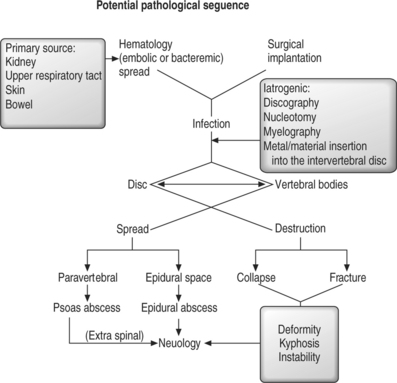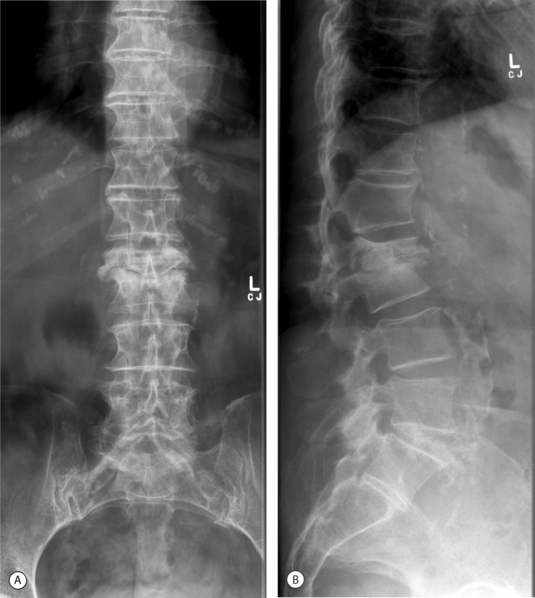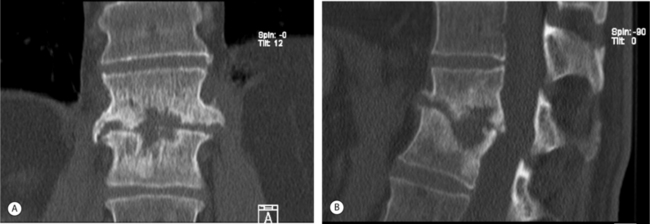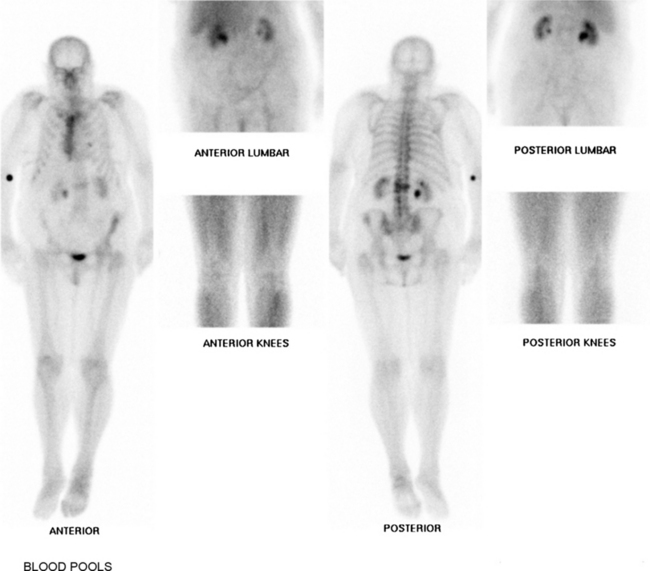CHAPTER 36 Spine Infections: An Algorithmic Approach
CHILDHOOD DISCITIS
Pathogenesis, etiology, and natural history
The natural history of childhood discitis varies from neonates/infants to young children to teenagers.1
Neonate/infant and young children discitis
A high proportion of negative disc cultures in infants and toddlers has prompted some authors to state that childhood discitis may be either inflammatory or infective. Infective childhood discitis usually results from hematogenous seeding of organisms. The intervertebral disc is avascular even in infants.2 It has been postulated that pediatric spine infections commence in the microarterioles of the vertebrae3 because the nutrient arteries have been demonstrated to be a more direct route for the spread of infection to the vertebral column than its venous drainage.3 This theory proposes that spinal infection in infants and toddlers starts in a very similar way to the development of metaphyseal osteomyelitis in long bone infection. Terminal arterioles arising from the circumferential vessels fed from the extraperichondrial arterial plexus and from nutrient metaphyseal arteries penetrate the hyaline cartilage endplates of the vertebral bodies and terminate adjacent to the intervertebral disc in neonates up to 1 year of age.2,4,5
Venous drainage follows the same route. Blood-borne bacteria can be delivered directly to the intervertebral disc during bacteremia.6 The pediatric host cannot mount a response to invading organisms within an avascular disc, allowing the organisms to multiply unimpeded. Pyogenic bacteria release proteolytic enzymes, leading to destruction of the intervertebral disc. Spread of infection to the vertebral body in infants is limited by the cartilage-capped endplates. However, with further progression, the hyaline cartilage-capped endplates may be destroyed, allowing the invading organisms direct access to the vertebral body.7 Infants have widespread anastomotic connections between intraosseous arterioles within the vertebral body.8 Disappearance of these anastomoses later in childhood increases the risk of vertebral bone necrosis and subsequent osteomyelitis through microthrombosis. Vertebral osteomyelitis is present in 25% of cases. Spread to the epidural space is rare in young children but has been reported in previously well males.9
Clinical presentation – history and clinical features
Childhood discitis is uncommon. The clinical presentation can be subdivided into three distinct age groups – neonates/infants, young children, and early teenagers. Infants and young children present acutely with malaise and a limp or refusal to bear weight on one leg.10 Brown et al.11 report an insidious onset of symptoms in young children with typical late presentation. Viral or bacterial infections often precede childhood discitis. A history of recent mild spinal trauma is sometimes elicited. Seventy-eight percent of cases involve the lumbar spine.12 Fifty percent to 57% of young children present with backache.10,13 Teenagers present with spinal and occasionally abdominal pain.14
The commonest clinical signs are trunk stiffness and a loss of the normal lumbar lordosis.11 Paravertebral muscle spasm and hamstring tightness are common. Some children may present with a totally rigid lumbar spine. Spinal tenderness is easier to detect in children old enough to communicate verbally. A minority (28%) of children with discitis are febrile (>37.9°C).12 If the disease progresses to spondylodiscitis (which includes vertebral osteomyelitis), up to 79% have an elevated temperature.12 Neurological deficit in this age group is rare.
ADULT PYOGENIC SPONDYLODISCITIS
Pathogenesis, etiology, and natural history
Spondylodiscitis may complicate generalized septicemia or result from a distant focus such as vegetation of a heart valve or florid skin infection. Blood-borne adult pyogenic spondylodiscitis originates in the endplate of the vertebra (rather than the intervertebral disc), most likely in the capillary loop or postcapillary venous channels, spreading secondarily to the intervertebral disc. Pyogenic bacteria secrete proteolytic enzymes, causing necrosis of bone and intervertebral disc.
Individuals at risk include those affected by:
Infection of males has a slight preponderance,15 with a male:female ratio ranging up to 1.8:1. If the patient has been previously well and the organism is indolent, the spondylodiscitis can be arrested at an early stage with nonoperative management. If the patient has been previously unwell and the organism is more virulent, the natural history of spondylodiscitis is of worsening local sepsis, sometimes spreading paravertebrally.
Infection may spread to form a psoas abscess and extend to its insertion at the lesser trochanter of the proximal femur. Epidural spread also occurs. The spinal cord or cauda equina may be compressed by an enlarging abscess, usually at one spinal level. The microvascular circulation from the anterior spinal artery to the spinal cord/cauda equina is also disturbed by the presence of microvascular thrombosis as a result of persisting adjacent infection.16
Prolonged immobilization with osteopenia and progressive vertebral osteomyelitis with bone destruction predispose to pathological fracture. The resultant angular kyphosis or posteriorly displaced bone fragments into the spinal canal may contribute to neurological compromise. Mortality has been reported in 10–16% of adults with pyogenic spondylodiscitis.17–19
Clinical presentation – history and clinical features
Patients typically present with insidious onset of unremitting spinal pain and loss of spinal movement. The clinical presentation can be classified into acute, subacute and chronic, depending on the virulence of the organism and the ability of the affected individual to mount a response.20 A history of malaise, anorexia, fevers, weight loss, and night or resting spinal pain is common. Most have a diminished range of movement and mild tenderness over the spinous process of the affected vertebra early in the disease.
With more-advanced spinal infection, neurological deficit is present in 29–51% of spondylodiscitis.17,18,21–23 Two-thirds of patients with paralysis from spinal infection have central cord syndrome and one-third have anterior cord syndrome.21 Neurological deficit is most common at the cervical spine level and least common at the lumbar level.
Factors associated with neurological deficit include diabetes mellitus, advancing age, steroid therapy, organ transplantation, chronic inflammatory conditions, and intravenous drug abuse.18
ADULT PYOGENIC DISCITIS
Pathogenesis, etiology, and natural history
True adult pyogenic discitis usually follows surgical intervention. The incidence following discography is 0.5–1% and following any type of spinal procedure 0.4–4%.24 It has been reported after every type of spinal procedure including laminectomy, discectomy, arthrodesis, discography, chemonucleolysis, myelography. and lumbar puncture. Discitis complicates discectomy in 0.4–2.8% of patients.24,25
Microdiscectomy using a microscope was reported to reduce the rate of discitis24 but others have found no difference in infection rate.26 It is probably due to direct inoculation of the organism into the avascular intervertebral disc although some believe that it results from aseptic inflammation.24 During the stage of suppuration, the invading organisms multiply and a surrounding inflammatory response is mounted by the host. In a similar manner to spondylodiscitis, the bacteria secrete proteolytic enzymes, leading to necrosis of the intervertebral disc and endplates. Again, the amount of disc destruction depends on the virulence of the invading organism and the resistance of the host. In a previously well patient, the discitis may be locally contained with little treatment, when the invading organism is indolent. However, the infection may spread to the vertebral endplates and beyond if the organism is virulent or in an immunocompromised individual. Should this occur, the pathogenesis and natural history of discitis is similar to that of adult pyogenic spondylodiscitis (Fig. 36.1).
Clinical presentation – history and clinical features
Pain is expected following a surgical procedure or injection.24 The clinical course of postprocedural discitis is often reflected by early relief of symptoms due to the surgical procedure, typically followed by recurrence of similar spinal pain 1–4 weeks after the procedure (range, 2 days to 10 weeks).27 The constant, throbbing pain that subsequently develops is often out of proportion to the clinical picture. Unlike postoperative deep wound infection, the surgical skin incision/scar is normal in more than 90% of cases.24 Most patients with postprocedural discitis have only a very mildly elevated temperature. They eventually develop malaise, anorexia and weight loss. Clinically, patients develop marked paravertebral muscle spasm and stiffness of the affected spine. Fewer than 15% of patients develop a new or worsening neurological deficit from the spread of infection.24,28
POSTOPERATIVE DEEP WOUND INFECTION
Pathogenesis, etiology, and natural history
Early wound complications of spine surgery
Early postoperative infections occur less frequently following discectomy (0.5–1%) than instrumented posterior spine arthrodesis (up to 12.9%).29 Laminectomy alone has been reported to result in a 1.5% wound infection rate. When arthrodesis is added, the risk increases 50%, and with the addition of instrumentation it increases 100%.29
The preoperative nutritional status of the patient is an important factor in the incidence of wound dehiscence and subsequent infection.30–32 Generally, patients have a better chance of uncomplicated postoperative wound healing with a plasma albumin level of greater than 3.5 g/dL and a total lymphocyte count of greater than 2000 cell/mm3.12
Preoperative radiation increases the risk of early wound complication in patients with spinal tumours.29,32 Risk factors for early wound complications include prolonged intraoperative time (>4 hours), massive blood loss, blood transfusions, large wound hematomas, posterior rather than anterior approach, and large numbers of operating theater personnel.33
Staphylococcus aureus accounts for approximately 60% of all infections. Other organisms implicated in primary and postprocedural pyogenic spinal infections are shown in Table 36.1. Patients with immune deficiency are susceptible to the rarer fungal organisms including those shown in Table 36.2.
Table 36.1 Other Organisms Implicated in Primary and Postprocedural Pyogenic Spinal Infections
| Actinomyces | Aerobacter |
| Bacteroides | Brucella |
| Enterobacter | Escherichia coli |
| Klebsiella | Proteus |
| Pseudomonas | Salmonella |
| Serratia | Streptococcus |
Table 36.2 Rarer Fungal Organisms
| Aspergillus | Candida |
| Coccidioides | Cryptococcus |
| Histoplasma | Nocardia |
Superficial wound infection may extend to involve deeper tissues, including the intervertebral disc, following spinal surgery. Prolonged surgical time may result in excess wound edema or ischemic/necrotic wound edges from prolonged skin edge retraction. Both complications allow virulent bacteria or normal skin flora to enter the wound. Skin flora of low virulence including Acinetobacter baumani, Peptiostreptococcus, Corynebacterium, coagulase-negative Staphylococcus, and Propionibacterium acnes have been cultured from postoperative surgical wounds in elective orthopedic surgery.34 Although S. aureus and methicillin-resistant S. aureus (MRSA) are the commonest hospital-based organisms responsible for early deep wound infection, some wound infections involve more than one organism and include indolent types of bacteria from normal skin flora.
Late infection and late hematogenous seeding
The range of organisms isolated from late infection of the spine following instrumented spine arthrodesis is similar to that of early wound infection. Embolization or bacteremia from the bladder, kidney, respiratory tract, skin, or bowel may result in hematogenous seeding in spinal instrumentation some time after surgery. Late infection can also follow intravenous drug abuse.35 The bacteria remain dormant for a period of time and secrete a glycocalyx which promotes their adherence to the metal of the spinal instrumentation and shields the organisms from lymphocytes and antibiotics.36–38 When the host develops an intercurrent illness and natural immunity is depressed, late spinal infection may develop. It is manifest as an initial suppurative phase with abscess formation, followed by reactive granulation tissue when the host mounts a response to the infection. Pyogenic bacteria secrete proteolytic enzymes, leading to necrosis of surrounding soft tissue and bone. Symptoms have usually developed by this stage and the patient may develop a painful swelling about the spinal instrumentation. Should the infection remain undiagnosed, a sinus may develop. Superficial drainage to the skin is not common in late pyogenic infection.
Sterile inflammation
Hematoma formation and sterile bursae are frequently evident between prominent metal and the skin in thin patients with posteriorly instrumented spinal arthrodesis. Corrosion and metal fretting with release of particulate metal from micromotion between coupled spinal instrumentation results in a sterile inflammatory response, even after solid arthrodesis.39,40 In most cases, cultures of the fluid and tissue adjacent to the metal implants are negative. Where bacteria can be cultured from the interface membrane, it is hypothesized that the metal particles and resultant inflammation may potentiate late infection due to activation of indolent organisms or hematological embolization.
Clinical presentation – history and clinical features
Deep spinal wound infection can be manifest in three clinical scenarios – early, delayed, and late. Early deep wound infection may follow a superficial wound infection from anterior or posterior spine surgery. The incidence of erythema, cellulitis, wound dehiscence, or purulent discharge before the onset of deep wound infection is up to 93%.29 Less than a one-third are noted to have a temperature of greater than 37.5°C at diagnosis. Delayed and late deep wound infections are reportedly due to or associated with intraoperative inoculation of indolent bacteria/fungi in the presence of metal fretting or from true late hematogenous seeding in spinal instrumentation. When intraoperative inoculation of indolent organisms occurs, some early wound erythema is often noted.29,41,42 Diagnosis is often made by exclusion. Clinical symptoms include spinal pain, malaise, anorexia, and subjective swelling within the spinal wound.43
EPIDURAL SPACE INFECTION
Pathogenesis, etiology, and natural history
Epidural infection is relatively rare but the incidence may be increasing due to a greater number of spinal procedures, epidural catheterization for pain control, intravenous drug abuse, and immunocompromised patients.23,44 Although they are distributed circumferentially around the spinal cord/cauda equina, anterior epidural space infection is more likely to be associated with spondylodiscitis than a posterior infective focus.
Posterior foci usually result from hematogenous spread and are associated with frequent venous puncture for steroid or antiinflammatory injection and acupuncture.45 Epidural space infections are more common in the thoracic and lumbar spines, and tend to spread rapidly, often spanning a number of spinal segments at the time of diagnosis. Neurological compromise and even paralysis can occur early in the course of the infection, being manifest in days rather than in weeks, as is sometimes the case in spondylodiscitis. A combination of neural compression and microvascular thrombosis of the vessels of the spinal cord are thought to be responsible. Neurological deficit has been described in 19–80% of cases.23,45 Rarely, other infections occur within the spinal canal, including subdural abscess and spinal cord abscess.
Clinical presentation – history and clinical features
Epidural infections affect patients of all ages (including children) and may present with signs of overwhelming infection including septicemia, bleeding diathesis, abrupt onset of paraplegia, and even adult respiratory distress syndrome with minimal overt signs of spinal infection. In contrast to spondylodiscitis, high fevers and rigors are noted early in the course of the infection. Affected individuals often have severe constitutional symptoms of malaise and anorexia. Neck rigidity is often seen in cervical epidural space infection. Meningeal irritation and radicular pain are often present. Classically, neurologic deficit is evident within 7–10 days of the onset of infection. Progressive neurologic deficits are present in 19–37% of cases,23,46 and are commoner in the thoracic spine (60% of these cases) than the cervical spine (33.3% of cases),46 although McHenry et al. report a higher incidence from cervical spine infection.18
PRIMARY AND POSTPROCEDURAL FACET JOINT INFECTION
Pathogenesis, etiology, and natural history
Even though the capsule of the lumbar facet joint has anterior perforations, paraspinal and intradural extension of the abscess is exceedingly rare.47,48 The sepsis is contained within the joint in most cases and causes localized spinal pain until drained. Severe neurological sequelae have not been reported in joint sepsis following facet joint infection.
Clinical presentation – history and clinical features
Suppurative facet joint arthritis is rare with less than 50 reported cases.47 The clinical features can mimic spondylodiscitis. It is a very rare complication following facet joint injection with only three cases reported to date.49 Because facet joint injection is gaining popularity in the therapeutic management of low back pain in Western medicine, an increase in incidence should be expected. Most patients undergoing this procedure have localized spinal pain with or without radiation. Often, the patient will have immediate benefit of pain relief while the local anaesthetic is effective. Postinjection suppurative arthritis is difficult to diagnose in the early stages because it is recognized that under normal circumstances, it may take up to 10 days for locally injected steroids to have a dampening effect on the pain. Pain localization usually occurs only when the infection is established. Patients with undiagnosed postinjection suppurative facet joint arthritis continue to deteriorate, with severe unremitting back pain.
DIAGNOSIS
There is no single diagnostic test for spinal infection.
Plain radiology
Childhood discitis
In the earliest stages of infection, loss of cervical or lumbar lordosis is seen on lateral plain radiographs.7 A reduced disc height and erosion of adjacent vertebral endplates is present in up to 76% childhood discitis of 2 weeks duration.7,12 Long-standing infection leads to scalloping of the vertebral endplates. Late angular kyphosis may develop from destruction of either the vertebral body or the growth plates or both. The differential diagnosis of childhood discitis includes vertebra plana secondary to eosinophilic granuloma, bone tumors, and Scheuermann’s kyphosis in adolescents. Plain radiographs of the spine can distinguish among these conditions at presentation in most cases.
Pyogenic spondylodiscitis
Depending on the nature of the invading organisms and the general condition of the patient, plain radiological changes appear from 2 weeks to 3 months after the onset of infection.50 Progressive narrowing of the disc space and irregularity and loss of the sharp, straight outline of the adjacent vertebral endplates is demonstrated better on lateral radiographs.51 Subchondral endplate lysis or defects may follow. Evidence of bone repair is manifest by hypertrophic or sclerotic bone formation adjacent to the vertebral endplate. With progression of the disease, paravertebral soft tissue swelling is evident on anteroposterior (AP) radiographs. A psoas abscess may form, changing the profile of the psoas shadow on AP radiographs. If gas is demonstrated in the soft tissues, anaerobic bacteria are usually responsible. With progressive osteomyelitis, bone destruction of the vertebral bodies may cause a pathological fracture,50 acute angular kyphosis or, less commonly, scoliosis. Pyogenic spondylodiscitis may heal by late bony or fibrous ankylosis (Fig. 36.2).
Axial and spiral CT
Pyogenic spondylodiscitis
Multiplanar (spiral) CT is the investigation of choice to demonstrate the presence and extent of paraspinal/psoas abscesses, because MRI sagittal plane sequences are usually limited laterally to the tips of the transverse processes. Spiral CT imaging has the added advantage of providing the clinician with a 3-D view of the vertebral bodies of the infected spine.50,51 CT-guided percutaneous spinal biopsy allows for precise direction and localization of the infected disc or paravertebral abscess. MR imaging is superior in differentiating among epidural blood, pus, or tumor (Fig. 36.3).
Nuclear medicine (scintigraphy)
Gallium is an analog of ferritin which is secreted by leukocytes. In111-WBC scans have a low sensitivity (17%).50,51 Ga-67 SPECT images are accurate in diagnosing spinal osteomyelitis in up to 91% of cases. Combined accuracy of Technetium 99 and Gallium 67 citrate scans is as high as 94%.50 Technetium 99 scanning is recommended in very young children when discitis is suspected and exact localization is difficult from history and clinical examination. The scan appearance may show a high probability of infection as early as 3–5 days after clinical symptoms develop.52,53 During the healing phase of infection, the Gallium-67 scan may become negative although the Technetium-99 scan remains positive.54 For this reason, Gallium-67 scan alone has been recommended for follow-up studies of disc space infections.55 The authors’ preferred recommendation is follow-up MRI with gadolinium, except when general anesthesia is required for children. Under these circumstances, follow-up Technetium-99 and Gallium-67 scans are both considered (Fig. 36.4)
Magnetic resonance imaging
Magnetic resonance imaging (MRI) is the investigation of choice in assessment of early spondylodiscitis.50 It allows for multiplanar imaging. It has a specificity of up to 94% in distinguishing among discitis, vertebral osteomyelitis, epidural, paraspinal and prevertebral abscess, transverse myelitis, and spinal cord or intradural suppuration with a sensitivity of up to 97%,56,57 when gadolinium is added for enhancement. Early infection can be detected on T1-weighted sequences, in which decreased signal intensity in the intervertebral disc and the adjacent vertebral bodies from edema is evident. The intranuclear cleft is nearly always demonstrable (94%)51 in normal discs and is not visible in discitis. Signal hyperintensity of the disc on T2-weighted images, combined with loss of disc height, is useful in identifying the infected disc. After discography or facet joint blocks, injected fluids demonstrate low signal intensity on T1-weighted sequences and high signal intensity on T2-weighted sequences, occasionally mimicking purulent fluid. T2-weighted images demonstrate increased signal intensity within the bone marrow of adjacent vertebral endplates in spondylodiscitis due to inflammatory changes. Axial plane gradient echo sequences are useful in distinguishing between normal and infected vertebral bodies. Fat suppression techniques are useful for differentiating inflammatory areas in the vertebral bodies from fatty marrow in older individuals. Fat suppression also distinguishes between epidural suppuration and epidural fat. Epidural abscesses demonstrate high signal on T2-weighted sequences and may be isointense with cerebrospinal fluid (CSF). Proton density-weighted sequences demonstrate a darker image for CSF than pus. Gadolinium enhances images when tissue is hypervascular, and can help distinguish infection from scar tissue, tumor, CSF, and chronic degenerative changes. Enhancement of the disc, vertebral endplates, and bone marrow on postgadolinium sequences is highly suggestive of pyogenic spondylodiscitis.50,58,59 Gadolinium is especially useful when the spinal cord or dural sac is compressed by abscess, distinguishing pus from surrounding edema fluid.50 The signal from the spinal cord may be hyperintense under compression but acute changes are felt to be reversible. Persisting spinal cord hyperintensity usually reflects cord ischemia or myelomalacic change.60
One favored protocol for MRI of cervical spine infections involves:60
Stay updated, free articles. Join our Telegram channel

Full access? Get Clinical Tree












